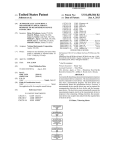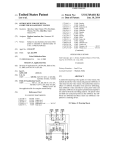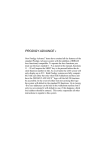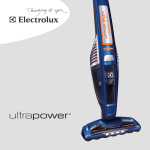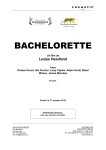Download Method and system for form-filling crawl and associating rich keywords
Transcript
USOO8793239B2
(12) United States Patent
(10) Patent N0.:
Dalvi et al.
(54)
(45) Date of Patent:
METHOD AND SYSTEM FOR
FORM_FILLING CRAWL AND ASSOCIATING
Y“,
RICH KE
(75)
US 8,793,239 B2
0RDS
IHVBIIIOFSI Nilesh Dalvi, MenlO Park, CA (Us);
Jul. 29, 2014
6,882,999 B2 *
6,950,821 B2 *
4/2005 Cohen et a1. ................ .. 707/694
9/2005 Faybishenko et a1. ...... .. 707/688
7,054,855 B2*
7,379,932 B2 *
5/2006 Basso et al. .......... .. 707/999.003
5/2008 Agrawal et al.
..... .. 707/710
7,519,902
4/2009
B1*
Kraft et al.
.....
7,533,085 B2 *
5/2009 Chang et a1.
Raghu Ramakrishnan, Los Altos, CA
7,546,370 B1 *
6/2009
(US)' Vinay Kakade Sunnyvale CA
7,599,931 B2 * 10/2009 Shi et a1. ...... ..
10/2011
6/2006
Acharya et a1. . . . .
Halevy et a1. ..
Zicherman . . . . .
. . . . . ..
715/234
707/999003
. . . . . .. 709/227
707/999.004
T
’
’
(US)’ Amp K‘fmar Shoudhun?
8,037,068 B2 *
2006/0129463 A1 *
Kamataka (1N), sathlya Keerthl
2006/0230033 A1 * 10/2006 Halevy et a1. ................... .. 707/3
Selvaraj, Cupertlno, CA (US); Philip
C t.
Bohannon, Cupertino, CA (US); Mani
Abrol, Karnataka (IN); David
CiemieWicz, Mountain View, CA (US);
Arun Shankar [yell Karnataka (IN);
VIPUI Agarwal, Karnamka (IN); AlOk 5'
Keral, Sunnyvale, CA (Us)
( on mue )
_
..... .. 707/736
. . . .. 705/26
d
OTHER PUBLICATIONS
Alvarez, Manuel, et al., “Crawling the Content Hidden Behind Web
Forms”, Lecture Notes in Computer Science, Computational Science
and Its ApplicationsiICCSA 2007, Springer Berlin/ Heidelberg,
ISBN 978-3-540-74475-7, vol. 4706/2007, Aug. 2007, 13 pages.
(73) A551gnee: Yahoo! Inc., Sunnyvale, CA (US)
(Continued)
(*)
Notice:
Subject to any disclaimer, the term of this
gage? 11552?];31Ldeg909r dZdJSuSted under 35
' i
i
y
y i
Primary Examiner * Pavlan Mamillapalli
(74) Attorney, Agent, or Firm * Hickman Palermo Truong
(21) Appl. NO.Z 12/576,011
Becker Bingham Wong LLP
(22) Filed:
(57)
Oct. 8, 2009
(65)
Prior PUblication Data
Us 2011/0087646 A1
Apr_ 14 2011
’
(51) Int. Cl.
G06]? 1 7/30
(200601)
(52)
(58)
G06F 7/00
us CL
ABSTRACT
Techniques are provided for the e?icient location, processing,
and retrieval of local product information derived from web
pages generally locatable through form queries submitted to
1
en ” web . 1 n
“deeP” or “h'dd
an embodiment, information such as product information and
we bp a 8 eso ftenre ferre d toasth e
(200601)
dealer-location information is located on a web page form
such as a dealer-locator form. After location of a suitable web
USPC ......................................... .. 707/709- 707/737
Page form, editorial wrapping is Performed ‘0 Create an auto
Field of Classi?cation Search
mated information extraction process. Using the automated
’
USPC
707/709 710
information extractor, deep-web crawling is performed. A
See a
histo
grid-based extraction of individual business records is per
pp
p
References Cited
(56)
’
ry'
U.S. PATENT DOCUMENTS
6,424,971 B1
6,654,741 B1*
formed, and matching and ingestion are performed in con
junction with a business listing database. Finally, metadata
tags are added to entries in the business listing database.
Metadata tags also may be added to entries in other databases.
7/2002 Kreulen et a1.
11/2003
Cohen et a1. ......... .. 707/999.004
20 Claims, 6 Drawing Sheets
US 8,793,239 B2
Page 2
(56)
References Cited
workshop on Geographic information retrieval, ISBN # 978-1
60558-253-5, 2008, 8 pages.
U.S. PATENT DOCUMENTS
Liu, Bing, et al., “Mining Data Records in Web Pages”, ACM, Pro
ceedings of the ninth ACM SIGKDD international conference on
2007/0022085 A1*
1/2007
2007/0143263 A1*
6/2007 Agrawal et al.
2007/0208703 A1*
2008/0040327 A1*
2008/0097958 A1*
9/2007 Shi et al. ......................... .. 707/3
2/2008 Chang et a1. .................... .. 707/3
4/2008 Ntoulas et al. .................. .. 707/2
2008/0195567 A1
2008/0259084 A1*
Kulkarni ......................... .. 707/1
.. 707/3
8/2008 Chen et al.
10/2008 Chang et a1. ................ .. 707/102
2009/0119157 A1
5/2009 Dulepet
2009/0119275 A1
5/2009 Chen et al.
Knowledge discovery and data mining, ISBN 1-58113-737-0, 2003,
6 pages.
He, Bing, et al., “Accessing the Deep WebiAttempting to locate and
quantify material on the Web that is hidden from typical search
techniques”, Communications of the ACM, vol. 50, Issue 5, May
2007, ACM at sixty: a look back in time, ISSN: 0001-0782, 7 pages.
Simon, Kai, et al., “ViPER: Augmenting Automatic Information
Extraction with Visual Perceptions”, Conference on Information and
2009/0204610 A1 *
8/2009
Hellstrom et al. .............. .. 707/5
Knowledge Management, Proceedings fo the 14th ACM international
2011/0202361 A1*
8/2011
Firminger et al. .............. .. 705/2
conference on Information and knowledge management, ISBN:
OTHER PUBLICATIONS
Alvarez, Manuel, et al., “Crawling Web Pages with Support for
Client-Side Dynamism”, Lecture Notes in Computer Science,
Advances in Web-Age Information Management, Springer Berlin/
Heidelberg, ISBN 978-3-540-35225-9, Jun. 2006, 11 pages.
Ciravegna, Fabio, et al., “Integrating Informatioon to Bootstrap
Information Extraction from Web Sites”, in IJCAI 2003 Workshop on
Intelligent Information Integration, 2003, 6 pages.
Mundluru, Dheerendranath, et al., “Experiences in Crawling Deep
1-59593-140-6, 2005, 8 pages.
Taiwanese Of?ce Action; TW Application No. 099134905, dated
Jun. 21, 2013, 13 pages.
Claims from TW Application No. 099134905, dated Jun. 21, 2013, 6
pages.
U.S. Appl. No. 12/615,243, ?led Nov. 9, 2009, Final Of?ce Action,
Apr. 23, 2012.
Taiwan Intellectual Property Of?ce, “Examination Opinions” in
application No. 99134905, dated Mar. 25, 2014, 4 pages.
Current Taiwan Claims in application No. 99134905, dated Mar.
2014, 4 pages.
Web in the Context of Local Search”, ACM, Workshop on Geo
graphic Information Retrieval, Proceedings of the 2nd international
* cited by examiner
US. Patent
Jul. 29, 2014
Sheet 1 0f6
US 8,793,239 B2
FIG. 1
100 \A
World Wide Web
Target
1le
Site DB
?
Editorial Form
cramer
Wrapper
L15—
L'LS
Fetch Patterns
Cra1VgOI-l5t
@
_.
Enumerate
URLs
iii
U S. Patent
Jul. 29, 2014
US 8,793,239 B2
Sheet 2 0f 6
E,02E3L$.Eu5xmm49.uN065Qz3E%“mOw.u»?
owm
0mm
US. Patent
Jul. 29, 2014
US 8,793,239 B2
Sheet 3 0f 6
cEf$gm5o?m
E@362 E23m
US. Patent
Jul. 29, 2014
Sheet 4 0f 6
US 8,793,239 B2
FIG. 4
Hidden Page DB
H5
402 X
Metadata
@
Tidy & LiSt
Segmentation
404
\ Address Extraction
406
630358
\ Phone # Extraction
408
\ Name Extraction
Business DB
\1/
HQ
410
X Duplicate Removal
412
414
\
Match
\
Validate
Category Feed
Statistics
(local)
£1.50
4.5.0
US. Patent
US 8,793,239 B2
Sheet60f6
www
m>m
szmh_
lew
_
4<0 4 meZsz a .60:
m2
i
_
_
_
_
_
_
_
_
gm
I 3_a
H222mesm2on
"m<8Q/E Z
_mam
E505iD2 qa3ma_
_29mow328m
Mmezo JOmHzo
3Q
US 8,793,239 B2
1
2
METHOD AND SYSTEM FOR
FORM-FILLING CRAWL AND ASSOCIATING
RICH KEYWORDS
FIG. 5 depicts the transformation of information stored in
hidden page database ?rst into list segments, and then into
extracted records; and
FIG. 6 depicts a computer system upon which an embodi
ment may be implemented.
CROSS-REFERENCE TO RELATED
APPLICATIONS
DETAILED DESCRIPTION
This application is related to application Ser. No. 12/408,
450, ?led Mar. 20, 2009, entitled “Apparatus And Methods
For Concept-Centric Information Extraction.”
In the following description, for the purposes of explana
tion, numerous speci?c details are set forth in order to provide
a thorough understanding of the present invention. It will be
apparent, however, that the present invention may be prac
ticed without these speci?c details. In other instances, well
FIELD OF THE INVENTION
The present invention relates to crawling and indexing web
known structures and devices are shown in block diagram
form in order to avoid unnecessarily obscuring the present
pages.
invention.
BACKGROUND
General Overview
As business pundits became aware of the amazing varieties
of electronic commerce fostered by the Internet and World
20
Wide Web, these pundits spread dire predictions of the death
of the so-called “brick-and-mortar” stores. But ordinary com
puterusers, possibly unaware of these predictions, found new
ted to web pages often referred to as the “deep” or “hidden”
web. These techniques promote an improved search experi
ways to incorporate on-line searching into old-fashioned
shopping habits.
25
Now shoppers may include on-line searches prior to mak
ing an “off-line” shopping trip to a local retailer. These shop
30
regarding target products or services. Unfortunately, many
shoppers waste time and resources in an attempt to search for
retailers by products sold or services provided, as the search
results fail to connect the seller, the product or the service, and
the location in a meaningful fashion.
mated information extractor, deep-web crawling is per
35
For example, a shopper may desire to use a search engine to
40
ment of establishments that retail costumes, sell ice cream, or
repair appliances. These establishments may have little or no
physical proximity to the shopper. The shopper must then
45
drawings and in which like reference numerals refer to similar
elements and in which:
FIG. 1 depicts a page crawler ?ow for use in the population
of a hidden page database;
FIG. 2 depicts a dealer-locater form web page having form
In an embodiment, a business record from the hidden web
data extraction is compared to one or more records from the
business listing database. In an embodiment, information
such as name, address, and telephone number of the extracted
business record is compared to corresponding information
from the business listing database.
Example Crawler Flow
50
BRIEF DESCRIPTION OF THE DRAWINGS
The present invention is illustrated by way of example, and
not by way of limitation, in the ?gures of the accompanying
formed. A grid-based extraction of individual business
records is performed, and matching and ingestion are per
formed in conjunction with a business listing database.
Finally, metadata tags are added to entries in the business
listing database. Metadata tags also may be added to entries in
other databases.
ranges, in what may be called a ‘buy near me’ search. How
weed through search results of dubious value.
The approaches described in this section are approaches
that could be pursued, but not necessarily approaches that
have been previously conceived or pursued. Therefore, unless
otherwise indicated, it should not be assumed that any of the
approaches described in this section qualify as prior art
merely by virtue of their inclusion in this section.
form such as a dealer-locator form. After location of a suitable
web page form, editorial wrapping is performed to create an
automated information extraction process. Using the auto
locate local establishments that sell Viking-brand cooking
ever, a search performed by a standard search engine using the
search terms “viking” and “range” may locate an odd assort
ence for a user desiring relevant product and business infor
mation local to the user, or with respect to any location
selected by the user.
In an embodiment, information, such as product informa
tion and dealer-location information, is located on a web page
pers use on-line searches to hunt for store directions, hours of
operation, and user reviews of the retail experience. These
shoppers often also use on-line searches to gather information
Techniques are provided for the ef?cient location, process
ing, and retrieval of local product information derived from
web pages generally locatable through form queries submit
55
FIG. 1 depicts a page crawler ?ow 100 used in the popu
lation of a hidden page database. Page crawler ?ow 100
includes target site database 110, editorial form wrapper 115,
fetch patterns database 120, enumerate URLs module 125,
crawl list 130, crawler 135, and hidden page database 145.
Page crawler ?ow 100 begins with an entry taken from
target site database 110 containing information regarding
dealer-locator web pages. For example, an entry in target site
database 110 may contain information regarding the link:
http://smallappliances.electroluxusa.com/node85.asp,
60
inputs;
FIG. 3 depicts an editorial form wrapper application input
(the “target web site”), corresponding to a dealer-locator page
for appliances manufactured under the “Electrolux” brand.
FIG. 2 depicts the dealer-locator web page 200 corresponding
to this link. Information in target site database 110 may be
screen for use by an editor to populate a fetch patterns data
compiled manually or compiled automatically through vari
base;
ous crawling procedures.
FIG. 4 depicts a listing extraction ?ow for extracting infor
mation corresponding to a single fetch pattern from crawled
pages stored in a hidden page database;
65
As shown in FIG. 2, a user desiring to ?nd an Electrolux
dealer in the user’s area must ?ll out form input information
including product 210 and Zip code 220. Some form informa
US 8,793,239 B2
3
4
tion input may contain default values that the user may over
based approach offers many bene?ts. For example, the
write. Once product 210 and Zip code 220 are selected, the
browser-based approach allows extremely fast wrapping of
user may activate submit button 230 to generate form results
simple forms, taking only a few minutes of an editor’s time.
Additionally, generating URLs from fetch patterns may be
easily incorporated into an existing crawler framework in
which the crawler is con?gured to issue http requests. This
corresponding to the input information selected.
Thus, harvesting of all relevant dealer-locator information
could be performed by a hardy user capable of performing
repeated query operations at the target web site, with the user
submitting varied form input, one product type and Zip code
approach requires less resources as compared to a con?gura
tion in which no URLs are generated and browser simulation
based techniques are used to get page content. Further, the
at a time. Instead, with respect to FIG. 1, as part of page
crawler ?ow 100, an editor takes information in target site
database 110 for input into editorial form wrapper 115. Edi
torial form wrapper 115 is a tool used to generate all possible
editor tool may be easily con?gured for other applications
outside of brick-and-mortar shopping, such as ?lling forms to
crawl health care provider websites or product manuals
offered on-line via form submission.
As a non-limiting example, a fetch pattern for the ?llable
form located at the website “brand.com” may have a format
of:
fetch patterns stored in fetch patterns database 120.
In an embodiment, editorial form wrapper 1 15 is a browser
plug-in combined with a small PHP web application. The
plug-in is able to capture any user input on a form page based
on “observing” the user’ s interaction with the form. To wrap
a particular form, such as the example shown in FIG. 2, the
editor ?rst opens the home page of the business, starts
“recording” and marks the page as the homepage using tool
bar buttons. Then the editor navigates to the locator form on
the site and ?lls in the form elements such as product 210 and
Zip code 220. These values are submitted to the form website,
http://brand.com/?Zip:$Z&cat:$C,
where $Z and $C each point to a dictionary of values for Zip
codes and product-categories, with the resulting list of fetch
20
tions; a sample entry in the resulting crawl list may be:
http://brand.com/?Zip:951 10&cat:Kitchen,
Such a resulting list of fetch-URLs is placed in crawl list
130 and used as input to crawler 135. With respect to the
which retrieves a list of store locations.
Once the form is submitted and a result page is returned, the
25
editor may stop recording the session. At this point, the plug
in may present, to the editor, the information captured by the
node85 .asp?Zip:95 l 29&cat:Brisa,
30
tain parameters from the user’s interaction. Once the editor
veri?es this information to be correct, the information is
submitted to a PHP server (not shown in FIG. 2).
35
have been ?lled in by the user. The server may identify the Zip
along with their dictionaries suitable for iteration, as shown in
FIG. 3, as part of the population of fetch patterns database
40
parameter found, with corresponding form parameter values
found in dictionary column 350. For example, parameter box
350 displays all possible values captured for the form param
eter “Category,” beginning with the value “Cleaning” and
tion from hidden page database 145 is now discussed below.
45
Example Extraction and Matching
50
Once hidden page database 145 is populated, business
listings are extracted. FIG. 4 depicts a listing extraction ?ow
for extracting information corresponding to a single fetch
pattern from crawled pages stored in hidden page database
55
145. Techniques of performing adaptive list matching are
additionally described in the related application entitled
“Apparatus And Methods For Concept-Centric Information
Extraction,” application Ser. No. l2/408,450, ?led on Mar.
20, 2009.
ending with the value “Trilobite.” The editor may select the
values to be iterated over during enumeration of URLs
through values selected in iteration column 370.
If there are any lists on the form which should remain ?xed
throughout the crawl, such as a list of allowed radius values
for search, then the editor may change those to ‘Selected
Value’ to indicate that those parameters need not be iterated
over. For example, in FIG. 3 the editor has decided that no
iteration over the form parameters “address,” “city,” “state,”
and “p” is necessary, whereas the form parameter “Zip” shall
area of a known region may be omitted for a search of loca
tions of a regional restaurant chain.
Once crawl list 130 is formed, crawler 135 crawls web sites
in World Wide Web 140 using crawl list 130, with results
placed in hidden page database 145. Extraction of informa
generated by the PHP web application for use by the editor to
populate fetch patterns database 120. Using text input box
310 and one or more save buttons 320, the editor may assign
a name to the particular pattern to be used in the enumeration
of URLs at step 125. Column 330 lists the name of each form
In an embodiment, the dictionary of values for Zip codes
corresponds to all known valid Zip codes; currently, the num
ber of valid Zip codes is approximately 42,000. In an embodi
ment, the set of Zip codes in the dictionary is selected based at
least in part on characteristics of the product, product manu
facture, or service. For example, valid Zip codes outside the
code parameter, if found, and identify other form parameters
120.
FIG. 3 depicts an editorial form wrapper input screen 300
corresponding to a search for Electrolux appliance dealers
that located in or near Zip code 95129 and that sell the “Brisa”
product line.
The server processes the form page contents and the user
actions on the form to determine the form parameters which
example illustrated FIGS. 2, 3, and 5 and the discussion
below, the entry in the resulting crawl list may be:
http://smallappliances.electroluxusa.com/
plug-in, such as the business name, the homepage URL, the
form page URL and candidate “fetch URLs”iweb requests
that are submitted during the session and that appear to con
URLs including all {Zip code, product category} combina
Information regarding a particular product, such as an
appliance, may be spread out over several fetch patterns, as
information such as service location may use a separate form
apart from the form used to locate dealer information.
60
Although FIG. 4 depicts extraction corresponding to a single
be iterated over using values taken from a ?le named “gred
fetch pattern, crawled pages in hidden page database 145
tool_Zip_prototype.” Similarly, as shown in FIG. 3, the editor
corresponding to multiple fetch patterns may be processed
has decided to iterate over all possible values of the form
concurrently so as to maximize the amount of information
parameter “Category.”
Upon review of the parameters, the editor may save a
extracted, and to increase the robustness of the information
65
extraction from defects such as typographical errors con
fetch-pattern in fetch pattern database 120. The fetch-pattern
tained in the crawled pages. Additional advantages of per
is used to generate URLs to crawl at step 125. The browser
forming extraction using multiple fetch patterns in parallel
US 8,793,239 B2
5
6
may include ease of scaling and a decrease in processing time.
An example of concurrent processing may be the concurrent
processing of both a fetch pattern corresponding to retailers
and a fetch pattern corresponding to repair facilities.
FIG. 5 depicts the transformation of information stored in
hidden page database 145 into list segments, and then into
extracted records. Form information 510 is a non-limiting
example of a portion of a web page crawled by crawler 135
and stored in hidden page database 145. For example, the
form information may contain raw HTML data and graphics
business database 440. In an embodiment, a candidate pool of
extracted records is formed by searching all extracted records
against business database 440 based upon matching address
or telephone information, followed by comparison of the
candidate pool of extracted records against business database
440 for matching business names.
A set of positive examples is formed using the set of suc
ces sful matches between the extracted records and matching
names in business database 440. This set of positive examples
is then used to auto-train a name wrapper. Then this name
wrapper is run against all extracted records to extract names
data, which, when rendered by a browser, would appear to the
user substantially as the table shown as form information 510.
for all extracted records.
After name extraction is performed on all extracted
With respect to FIG. 4, extraction begins at step 402, in
which web page data corresponding to a selected fetch URL
records, it is likely the results include many duplicate records.
For example, a store located in a particular zip code will likely
pattern is input from hidden page database 145. Metadata
from metadata database 420 may also be input. In an embodi
appear in results from a fetch URL corresponding to an adja
cent zip code, as most forms return store locations within a
ment, metadata is added to entries during population of hid
den page database 145.
In an embodiment, metadata corresponding to the type of
business, product, or service is added to the web page data, for
use in tagging the resulting business records with information
relevant to the search engine user; for example, the tag
“repair” may be added to business records from crawling a
web site of a product’s authorized repair establishments.
Similarly, a set of tags corresponding to product brands
particular radius of distance from the input zip code. Dupli
20
cates are removed at step 410. In an embodiment, duplicates
are removed by performing an exact match on extracted
name, address, and telephone information.
Final matching of each (de-duped) extracted record is per
formed at step 412. In an embodiment, each record is com
25
pared against business database 440 to determine a match
repaired by a particular authorized repair establishment may
score. In an embodiment, a match score is based upon a fuzzy
be added to the business records.
match using the business name attribute, and exact matches
on the address and telephone attributes. A match score above
In step 402, extraneous information, such as graphics and
special characters, are removed from the data and the result
ing tidied pages are segmented into extracted records. Each
extracted record corresponds to a single business from which
individual list items will be extracted. For example, a single
30
in which the business name attribute does not exactly match
the business name appearing in business database 440, the
business name appearing in business database 440 is used as
the business name attribute.
extracted record may comprise one or more of the following:
extracted name, extracted address, and extracted phone num
ber. With respect to FIG. 5, a depiction of a sample extracted
35
record appears as extracted record 520. Extracted record 520
40
statistics are placed in statistics database 460. In an embodi
45
ment, additional metadata, either supplied by metadata 420 or
supplied by a separate source, is included with extracted
records placed in category feed 450. In an embodiment,
records placed in category feed 450 are used to augment
corresponding records in business database 440.
to performing extraction on a user manual, a single extracted
record may comprise items such as extracted index, extracted
warranty, extracted parts list, and extracted assembly instruc
tions. Similarly, with respect to performing extraction on a
hidden database of health care providers, a single extracted
record may comprise items such as medical doctor’s name,
address, list of specialties, and education.
For each extracted record, at step 404 address information
is extracted. In an embodiment, ?elds including street num
ber, street name, city, zip code and state are extracted. In an
50
embodiment, ?eld values are compared to geographic data
base 430 containing geographic information, from which a
latitude and longitude are obtained for the address.
Phone number extraction is performed at step 406. In an
embodiment, a set of regular expressions that identify tele
phone numbers in various United States and international
55
While in one embodiment the business listings may be
stored in a database (as described above), in alternative
embodiments, the business listings may be stored in other
kinds of data repositories, including repositories that are not
databases.
With respect to FIG. 5, the ?nal record placed in category
feed 450 includes business name 530 having value “Spencer
Knight Kitchen Design”, address 540 having value “657
Townsend St., San Francisco, Calif. 94103,” and telephone
550 having value “(415)558-8178.” Although not shown in
FIG. 5, metadata tags attached to one or more of business
name 530, address 540, and telephone 550 may have values
such as “Electrolux,” “dealer,” and “Brisa.” Information from
category feed 450 could then be transferred into business
formats, are applied. In an embodiment, a similar extraction
to locate facsimile telephone numbers is performed.
Name extraction is performed at step 408 using an auto
trained name wrapper in which extracted records from a
Editorial validation of both matched and unmatched
records is performed at step 414. In an embodiment, a random
sample of matched and unmatched records is selected for
validation. Upon successful validation, a feed of extracted
records is placed in category feed 450 and feed summary
corresponds to a single business location from form informa
tion 510.
Other extractions, corresponding to the type of web site
information crawled, are possible. For example, with respect
a selected threshold value is determined to have resulted in a
successful match. In an embodiment, for a successful match
60
database 440. Thus a search engine user issuing a search
particular fetch URL are compared to business listing infor
query “Brisa dealer” to one or more databases including
mation found in business database 440. In an embodiment,
business database 440 comprises a business database formed
through a conventional crawl of web pages.
business database 440 could easily obtain the desired local
dealer information without having to wade through extrane
The wrapper is auto-trained by locating name matches
between the extracted records and the business database 440.
In an embodiment, all extracted records are compared against
ous materials.
65
Although the process above is detailed with reference to
name, address, and telephone information, other types of
information may be extracted from hidden page database 145.
US 8,793,239 B2
7
8
For example, form results that could be extracted using the
techniques described above include hours of operation, holi
days, and parking information. Form results extracted for
tions to processor 604 and for controlling cursor movement
food establishments could include food types and menus. As
(e.g., y), that allows the device to specify positions in a plane.
Computer system 600 may implement the techniques
on display 612. This input device typically has two degrees of
freedom in two axes, a ?rst axis (e.g., x) and a second axis
described earlier, these techniques may also be extended into
the automated indexing of hidden web sites corresponding to
product manual information or medical provider databases.
Additionally, these techniques may be used to index hidden
web pages into a regular search engine. For example, a “store
details” web page previously accessible only through a form
described herein using customized hard-wired logic, one or
more ASle or FPGAs, ?rmware and/or program logic which
in combination with the computer system causes or programs
computer system 600 to be a special-purpose machine.
According to one embodiment, the techniques herein are
performed by computer system 600 in response to processor
web page could be indexed in a search engine database in
order to make the store details web page locatable through a
standard search query.
604 executing one or more sequences of one or more instruc
tions contained in main memory 606. Such instructions may
be read into main memory 606 from another storage medium,
such as storage device 610. Execution of the sequences of
instructions contained in main memory 606 causes processor
604 to perform the process steps described herein. In altema
Hardware Overview
According to one embodiment, the techniques described
tive embodiments, hard-wired circuitry may be used in place
herein are implemented by one or more special-purpose com
puting devices. The special-purpose computing devices may
be hard-wired to perform the techniques, or may include
20
of or in combination with software instructions.
The term “storage media” as used herein refers to any
digital electronic devices such as one or more application
media that store data and/ or instructions that cause a machine
speci?c integrated circuits (ASle) or ?eld programmable
to operation in a speci?c fashion. Such storage media may
comprise non-volatile media and/or volatile media. Non
gate arrays (FPGAs) that are persistently programmed to
volatile media includes, for example, optical or magnetic
perform the techniques, or may include one or more general
purpose hardware processors programmed to perform the
techniques pursuant to program instructions in ?rmware,
25
memory, other storage, or a combination. Such special-pur
pose computing devices may also combine custom hard
wired logic, ASle, or FPGAs with custom programming to
accomplish the techniques. The special-purpose computing
30
devices may be desktop computer systems, portable com
puter systems, handheld devices, networking devices or any
other device that incorporates hard-wired and/or program
of storage media include, for example, a ?oppy disk, a ?exible
disk, hard disk, solid state drive, magnetic tape, or any other
magnetic data storage medium, a CD-ROM, any other optical
data storage medium, any physical medium with patterns of
holes, a RAM, a PROM, and EPROM, a FLASH-EPROM,
logic to implement the techniques.
For example, FIG. 6 is a block diagram that illustrates a
computer system 600 upon which an embodiment of the
disks, such as storage device 610. Volatile media includes
dynamic memory, such as main memory 606. Common forms
35
invention may be implemented. Computer system 600
NVRAM, any other memory chip or cartridge.
Storage media is distinct from but may be used in conjunc
tion with transmission media. Transmission media partici
pates in transferring information between storage media. For
example, transmission media includes coaxial cables, copper
wire and ?ber optics, including the wires that comprise bus
includes a bus 602 or other communication mechanism for
602. Transmission media can also take the form of acoustic or
communicating information, and a hardware processor 604
light waves, such as those generated during radio-wave and
infra-red data communications.
coupled with bus 602 for processing information. Hardware
processor 604 may be, for example, a general purpose micro
40
Various forms of media may be involved in carrying one or
processor.
more sequences of one or more instructions to processor 604
for execution. For example, the instructions may initially be
Computer system 600 also includes a main memory 606,
such as a random access memory (RAM) or other dynamic
carried on a magnetic disk or solid state drive of a remote
storage device, coupled to bus 602 for storing information and
computer. The remote computer can load the instructions into
its dynamic memory and send the instructions over a tele
phone line using a modem. A modem local to computer
system 600 can receive the data on the telephone line and use
instructions to be executed by processor 604. Main memory
606 also may be used for storing temporary variables or other
intermediate information during execution of instructions to
be executed by processor 604. Such instructions, when stored
in storage media accessible to processor 604, render com
puter system 600 into a special-purpose machine that is cus
an infra-red transmitter to convert the data to an infra-red
50
tomized to perform the operations speci?ed in the instruc
tions.
Computer system 600 further includes a read only memory
(ROM) 608 or other static storage device coupled to bus 602
for storing static information and instructions for processor
604. A storage device 610, such as a magnetic disk or optical
55
60
services digital network (ISDN) card, cable modem, satellite
modem, or a modem to provide a data communication con
nection to a corresponding type of telephone line. As another
communicating information and command selections to pro
communicating direction information and command selec
618 provides a two-way data communication coupling to a
network link 620 that is connected to a local network 622. For
example, communication interface 618 may be an integrated
ing alphanumeric and other keys, is coupled to bus 602 for
cessor 604. Another type of user input device is cursor control
616, such as a mouse, a trackball, or cursor direction keys for
on bus 602. Bus 602 carries the data to main memory 606,
from which processor 604 retrieves and executes the instruc
tions. The instructions received by main memory 606 may
optionally be stored on storage device 610 either before or
after execution by processor 604.
Computer system 600 also includes a communication
interface 618 coupled to bus 602. Communication interface
disk, is provided and coupled to bus 602 for storing informa
tion and instructions.
Computer system 600 may be coupled via bus 602 to a
display 612, such as a cathode ray tube (CRT), for displaying
information to a computer user. An input device 614, includ
signal. An infra-red detector can receive the data carried in the
infra-red signal and appropriate circuitry can place the data
65
example, communication interface 618 may be a local area
network (LAN) card to provide a data communication con
nection to a compatible LAN. Wireless links may also be
US 8,793,239 B2
10
implemented. In any such implementation, communication
interface 618 sends and receives electrical, electromagnetic
or optical signals that carry digital data streams representing
various types of information.
Network link 620 typically provides data communication
wherein the method is performed by one or more comput
ing devices.
2. The method of claim 1, further comprising:
automatically comparing said ?rst record to a third record
from the business listing database;
based on the comparison, automatically determining
through one or more networks to other data devices. For
example, network link 620 may provide a connection through
whether the ?rst record and the third record both
local network 622 to a host computer 624 or to data equip
ment operated by an Internet Service Provider (ISP) 626. ISP
626 in turn provides data communication services through the
describe an identical business.
10
world wide packet data communication network now com
monly referred to as the “Internet” 628. Local network 622
3. The method of claim 1, wherein said producing one or
more URL fetch patterns corresponding to the particular web
form based, at least in part, on the observed user interaction
further comprises:
and Internet 628 both use electrical, electromagnetic or opti
automatically processing the observed user interaction and
cal signals that carry digital data streams. The signals through
the various networks and the signals on network link 620 and
one or more candidate fetch URLs that are submitted as
through communication interface 618, which carry the digital
a result of the observed user interaction to determine a
particular template URL for the particular web form and
data to and from computer system 600, are example forms of
transmission media.
Computer system 600 can send messages and receive data,
including program code, through the network(s), network
a set of parameters included in the particular template
URL;
20
application program through Internet 628, ISP 626, local
network 622 and communication interface 618.
The received code may be executed by processor 604 as it
is received, and/or stored in storage device 610, or other
non-volatile storage for later execution.
wherein the ?rst value for the particular parameter is indi
25
particular dictionary further comprises:
receiving, via a control associated with the particular
tion have been described with reference to numerous speci?c
parameter on a graphical user interface, information that
30
5. The method of claim 1, wherein the business listing
35
6. The method of claim 1, wherein the one or more tags are
business listing database.
7. The method of claim 1, further comprising modifying,
element, property, feature, advantage or attribute that is not
40
What is claimed is:
base.
8. The method of claim 1, wherein at least one tag of the one
45
50
generated URLs;
wherein the ?rst and second values are included in the set
automatically crawling the ?rst URL to obtain a ?rst
of one or more values.
55
automatically extracting business information from the
?rst record;
wherein the second value is distinct from the ?rst value;
automatically crawling the second URL to obtain a second
record; and
automatically extracting second business information from
the second record;
10. A computer-implemented method comprising:
automatically populating one or more ?elds of a form on a
?rst web page that is used to locate stores that carry
products that belong to a particular brand;
applying one or more tags, based on the business informa
tion, to an entry in a business listing database;
generating a second URL, based, at least in part, on the one
or more URL fetch patterns, wherein the second URL
includes a second value for the particular parameter;
receiving information identifying a set of one or more
values, for the particular parameter, to be included in
the particular web form;
record;
or more tags comprises a product brand name and the one or
more tags describe (1) products for sale, or (2) services per
formed by a business having the entry in the business listing
database.
9. The method of claim 1, further comprising:
web form;
producing one or more URL fetch patterns corresponding
to the particular web form based, at least in part, on the
observed user interaction;
generating a ?rst URL, based, at least in part, on the one or
more URL fetch patterns, wherein the ?rst URL includes
a ?rst value for a particular parameter associated with
based, at least in part, on the business information extracted
from at least the ?rst record, information in one or both of (l)
the business listing database, and (2) a search engine data
sense.
1. A method comprising:
automatically observing user interaction with a particular
database is constructed using a web crawler.
used to identify results of a search query performed using the
of such terms as used in the claims. Hence, no limitation,
expressly recited in a claim should limit the scope of such
claim in any way. The speci?cation and drawings are, accord
ingly, to be regarded in an illustrative rather than a restrictive
identi?es the particular dictionary; and
associating the particular dictionary with the particular
parameter.
invention, and is intended by the applicants to be the inven
tion, is the set of claims that issue from this application, in the
speci?c form in which such claims issue, including any sub
sequent correction. Any de?nitions expressly set forth herein
for terms contained in such claims shall govern the meaning
cated by the particular dictionary.
4. The method of claim 3, wherein said identifying the
In the foregoing speci?cation, embodiments of the inven
details that may vary from implementation to implementa
tion. Thus, the sole and exclusive indicator of what is the
wherein the set of parameters includes the particular
parameter;
identifying a particular dictionary for the particular param
eter;
link 620 and communication interface 618. In the Internet
example, a server 630 might transmit a requested code for an
receiving, in response to a submission of said form, one or
60
more records that indicate one or more geographical
locations of stores that each carry products that belong to
said particular brand;
locating, within a business listing repository, and based on
?rst contact information that is contained in a ?rst record
of said one or more records, a second record that con
tains second contact information that matches said ?rst
contact information;
US 8,793,239 B2
11
12
wherein said second contact information was extracted
from a second web page by an automated web crawler
applying one or more tags, based on the business informa
tion, to an entry in a business listing database;
generating a second URL, based, at least in part, on the one
or more URL fetch patterns, wherein the second URL
includes a second value for the particular parameter;
that automatically follows hyperlinks between web
Pages;
storing data that associates said particular brand with said
second record;
receiving a query that indicates both (a) a particular geo
wherein the second value is distinct from the ?rst value;
automatically crawling the second URL to obtain a second
graphical location and (b) said particular brand;
record; and
automatically extracting second business information from
in response to receiving said query, determining, based at
least in part on said data, that said second record is
the second record.
associated with both (a) said particular geographical
location and (b) said particular brand; and
13. The one or more non-transitory computer readable
media of claim 12, further comprising instructions for:
automatically comparing said ?rst record to a third record
from the business listing database;
based on the comparison, automatically determining
in response to determining that said second record is asso
ciated with both (a) said particular geographical location
and (b) said particular brand, generating a search results
web page that contains at least a portion of said second
contact information from said second record;
wherein the method is performed by one or more comput
whether the ?rst record and the third record both
ing devices.
11. One or more non-transitory computer readable media
storing instructions which, when executed by one or more
20
fetch patterns corresponding to the particular web form
computing devices, cause:
based, at least in part, on the observed user interaction further
comprises:
automatically populating one or more ?elds of a form on a
?rst web page that is used to locate stores that carry
products that belong to a particular brand;
describe an identical business.
14. The one or more non-transitory computer readable
media of claim 12, wherein said producing one or more URL
automatically processing the observed user interaction and
25
one or more candidate fetch URLs that are submitted as
receiving, in response to a submission of said form, one or
a result of the observed user interaction to determine a
more records that indicate one or more geographical
particular template URL for the particular web form and
locations of stores that each carry products that belong to
a set of parameters included in the particular template
said particular brand;
locating, within a business listing repository, and based on
30
?rst contact information that is contained in a ?rst record
identifying a particular dictionary for the particular param
eter;
tains second contact information that matches said ?rst
contact information;
35
dictionary further comprises:
40
identi?es the particular dictionary; and
associating the particular dictionary with the particular
parameter.
in response to receiving said query, determining, based at
least in part on said data, that said second record is
45
constructed using a web crawler.
ciated with both (a) said particular geographical location
and (b) said particular brand, generating a search results
producing one or more URL fetch patterns corresponding
to the particular web form based, at least in part, on the
observed user interaction;
generating a ?rst URL, based, at least in part, on the one or
more URL fetch patterns, wherein the ?rst URL includes
a ?rst value for a particular parameter associated with
the particular web form;
automatically crawling the ?rst URL to obtain a ?rst
record;
automatically extracting business information from the
?rst record;
16. The one or more non-transitory computer readable
media of claim 12, wherein the business listing database is
in response to determining that said second record is asso
computing devices, cause:
automatically observing user interaction with a particular
web form;
receiving, via a control associated with the particular
parameter on a graphical user interface, information that
graphical location and (b) said particular brand;
web page that contains at least a portion of said second
contact information from said second record.
12. One or more non-transitory computer readable media
storing instructions which, when executed by one or more
cated by the particular dictionary.
media of claim 14, wherein said identifying the particular
Pages;
associated with both (a) said particular geographical
location and (b) said particular brand; and
wherein the ?rst value for the particular parameter is indi
15. The one or more non-transitory computer readable
that automatically follows hyperlinks between web
storing data that associates said particular brand with said
second record;
receiving a query that indicates both (a) a particular geo
wherein the set of parameters includes the particular
parameter;
of said one or more records, a second record that con
wherein said second contact information was extracted
from a second web page by an automated web crawler
URL;
17. The one or more non-transitory computer readable
media of claim 12, wherein the one or more tags are used to
50
identify results of a search query performed using the busi
ness listing database.
18. The one or more non-transitory computer readable
media of claim 12, further comprising instructions for modi
fying, based, at least in part, on the business information
55
extracted from at least the ?rst record, information in one or
both of (l) the business listing database, and (2) a search
engine database.
19. The one or more non-transitory computer readable
media of claim 12, wherein at least one tag of the one or more
tags comprises a product brand name and the one or more tags
describe (1) products for sale, or (2) services performed by a
business having the entry in the business listing database.
20. The one or more non-transitory computer readable
media of claim 12, further comprising instructions for:
receiving information identifying a set of one or more
values, for the particular parameter, to be included in
generated URLs;
US 8,793,239 B2
14
13
wherein the ?rst and second values are included in the set
of one or more values.
*
*
*
*
*















